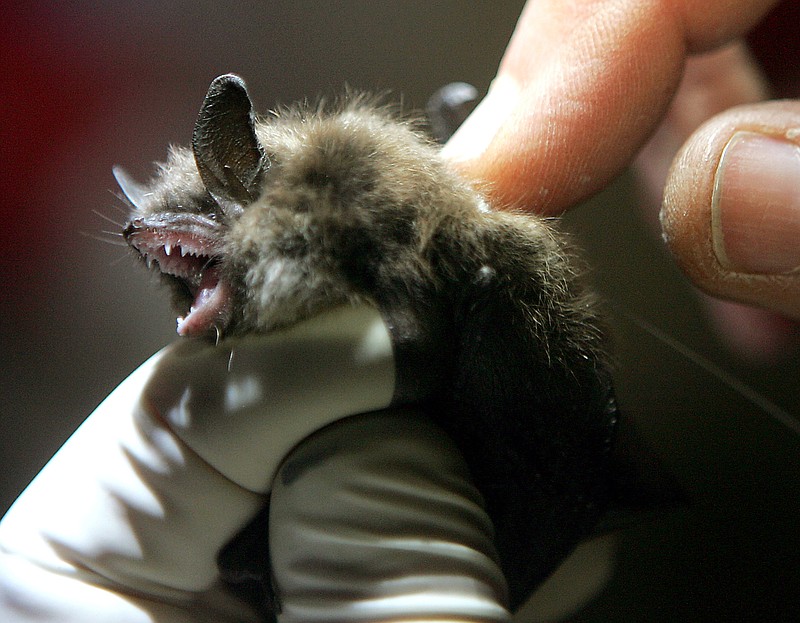Biologists this week confirmed the first Tennessee cases of a bat fungus that could cause mass die-offs among some of nature's best bug controllers.
"We will notice a marked increase in insects in our backyards and our gardens," said Don King, a Tennessee Wildlife Resources Agency spokesman.
The agency announced Tuesday that two tri-colored bats hibernating in an East Tennessee cave tested positive for white nose syndrome, a fungus already responsible for the deaths of thousands of bats in the Northeast.
Richard Kirk, endangered species coordinator for the resources agency, said Tennesseans may feel the repercussions of the disease and die-offs soon, which also could push the endangered Indiana and gray bats to extinction.
The fast-spreading fungus killed at least 95 percent of bats at one New York hibernation site in two years, he said. Biologists first found the disease at four sites in New York in the winter of 2006 and 2007, he said, and it now has spread to nine states, including Virginia and the Volunteer State.
"We have a lot more caves in Tennessee," Mr. Kirk said.
The infected bats were hibernating in Worley's Cave in Sullivan County, located on the Virginia state line in far northeastern Tennessee.
Scientists are trying to determine the cause of the fungus. They believe it can be transmitted from cave to cave on the shoes and equipment of cavers, but it also is believed to be transmitted from bat to bat.
There have been no reported human illnesses attributed to white nose syndrome, and there is no current evidence to suggest it is harmful to humans or other organisms.
The fungus that appears on the faces, ears, wings and feet of hibernating bats causes infected bats to lose weight. Hungry, the bats leave the cave early in search of food. Since the insects they normally eat are unavailable at that time, the bats find nothing to eat, biologists say.
"They literally starve to death," said Cherokee National Forest wildlife biologist Laura Lewis, who has said she especially is concerned about endangered and threatened species of bats locally.
FAST FACTThe loss of 500,000 bats would mean 2.4 million pounds of mosquitos and bugs aren't eaten in a year.Source: Richard Kirk, Tennessee Wildlife Resources AgencyABOUT BATS* Bats can eat up to 1,200 mosquitoes in an hour.* More than half of the bat species in the United States are in severe decline or are listed as endangered.* Bats can live to be more than 30 years old, and most have only one pup a year, making them extremely vulnerable to extinction.* Bat colonies can contain millions of bats, with young pups clustering in groups of up to 500 per square foot.* Bat mothers can find their babies among thousands or millions of other bats by their voices and scents.* 40 species of bats live in the United States; 15 live in Tennessee.* With more than 900 species worldwide, bats make up one-quarter of the world's mammal population.Source: The Nature Conservancy and other natural resources Web sites
The Indiana bat hibernates in a very small number of caves, she said, and if those caves become infected, the species could vanish.
Three Cherokee National Forest caves are homes to gray bats, as well as Rafinesque's big-eared bats and smallfooted bats -- both designated as threatened, she said.
Mr. King said wildlife officials do not know if other Tennessee caves hold infected bats. Some limited testing is being done as naturalists make biennial population counts, but experts are not going from cave to cave since they don't want to chance further spreading of the illness.
Last spring, the state of Tennessee, the U.S. National Park Service, the USDA Forest Service and Tennessee Valley Authority closed caves on public lands in Tennessee in an attempt to slow the spread of the fungus. The Nature Conservancy also closed caves located on its lands in Tennessee.
"Temporarily staying out of caves and mines is the one thing we can do right now to slow the transmission of white nose syndrome," said Cory Holliday, cave manager for The Nature Conservancy in Tennessee.
Worley's Cave, where the disease is confirmed, is privately owned and, though it is designated a state natural area, neither state nor federal officials have the authority to order it closed to cavers, Mr. Kirk said.
"Last summer, we asked everybody to educate themselves on it and think about the bats," he said. "And we'll appeal to the landowners (of caves.)"
